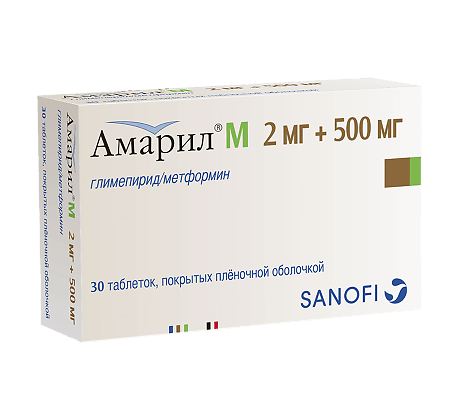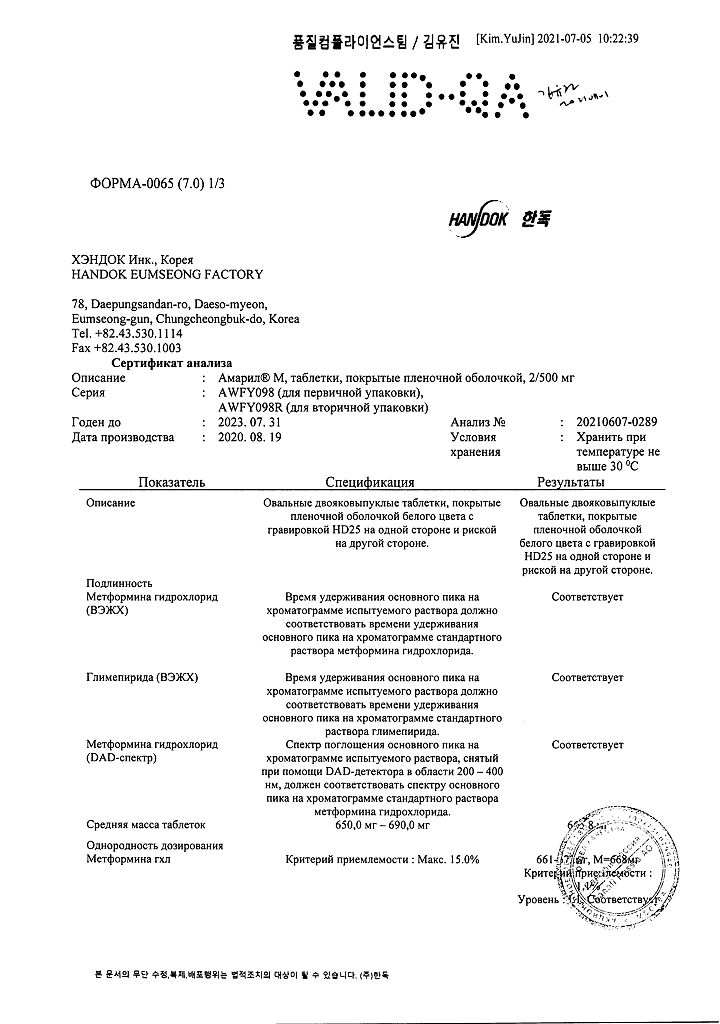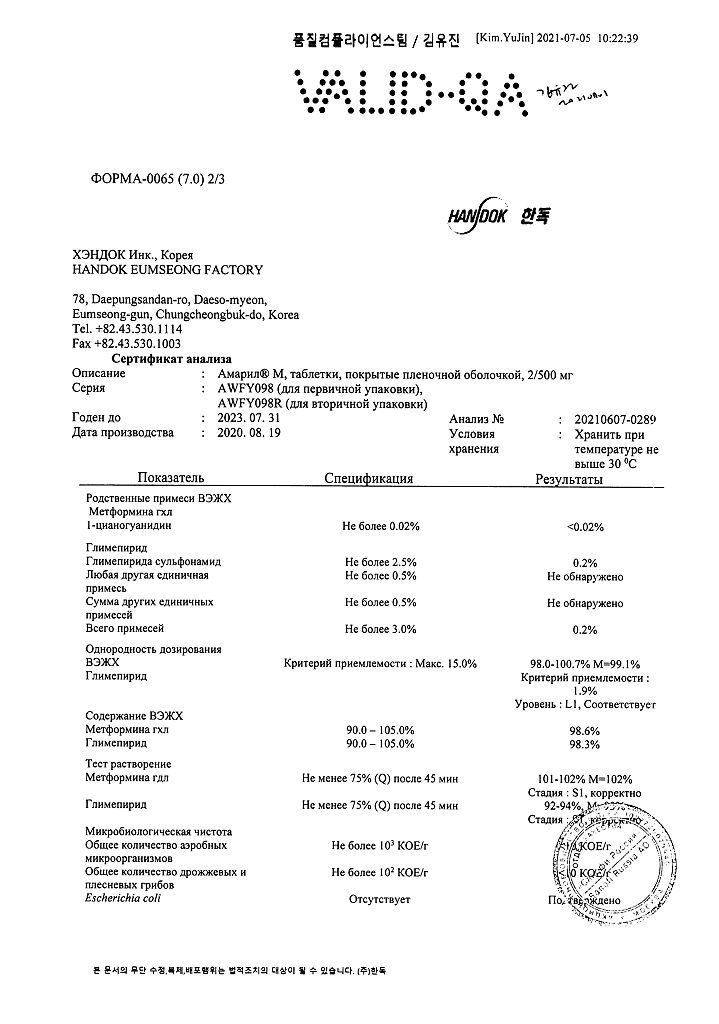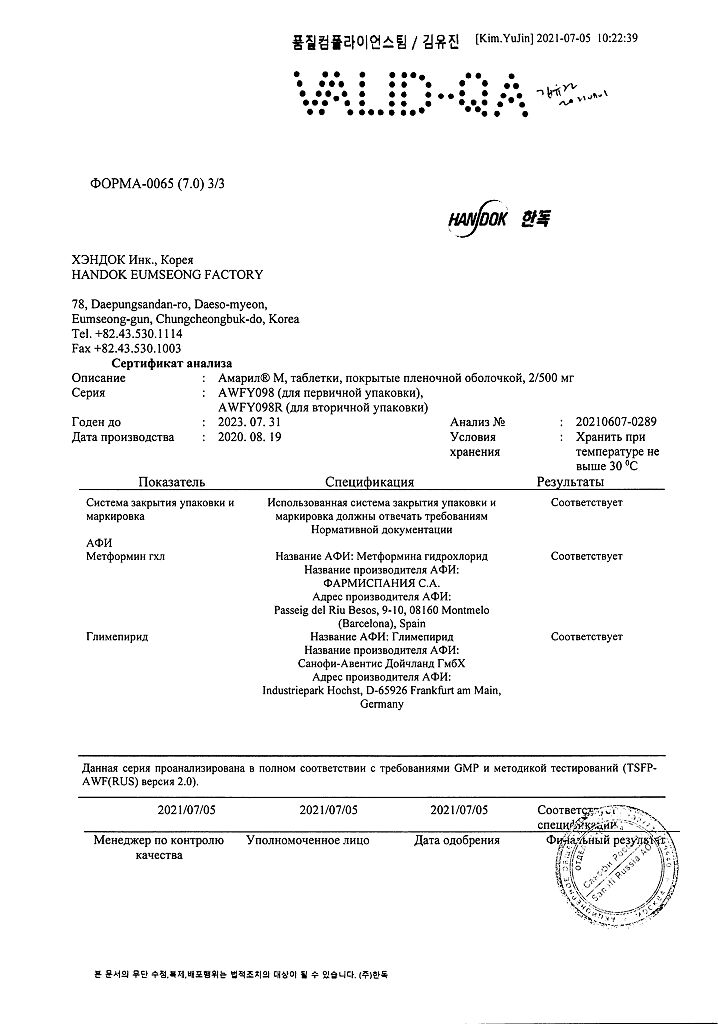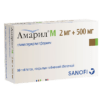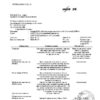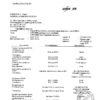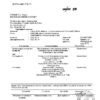No products in the cart.
Amaril M, 2 mg+500 mg 30 pcs
€34.80 €29.00
Description
Pharmacodynamics
Amaril® M is a combined hypoglycemic drug consisting of glimepiride and metformin.
Pharmacodynamics of glimepiride
Glimepiride, one of the active substances of Amaril® M, is an oral hypoglycemic drug, a 3rd generation sulfonylurea derivative.
The glimepiride stimulates secretion and release of insulin from the β-cells of the pancreas (pancreatic action) and improves the sensitivity of peripheral tissues (muscle and fat) to the action of endogenous insulin (extrapancreatic action).
Impact on insulin secretion
Sulfonylurea derivatives increase insulin secretion by closing ATP-dependent potassium channels located in the cytoplasmic membrane of pancreatic β-cells.
Closing potassium channels causes depolarization of β-cells, which promotes the opening of calcium channels and increases calcium entry into the cells. Glimepiride binds to and detaches from the pancreatic β-cell protein (mol mass 65 kD/SURX) with a high substitution rate, which associates with ATP-dependent potassium channels, but differs from the binding site of conventional sulfonylurea derivatives (protein with a mol mass 140 kD/SUR1). This process leads to the release of insulin by exocytosis, and the amount of insulin secreted is significantly lower than with second-generation sulfonylurea derivatives (e.g., glibenclamide). The minimal stimulating effect of glimepiride on insulin secretion also provides a lower risk of hypoglycemia.
Extrapancreatic activity
Like traditional sulfonylurea derivatives, but to a much greater extent, glimepiride has pronounced extrapancreatic effects (reduction of insulin resistance, antiatherogenic, antiaggregant and antioxidant effects). Glucose utilization by peripheral tissues (muscle and fat) occurs through special transport proteins (GLUT1 and GLUT4) located in cell membranes. Glucose transport to these tissues in type 2 diabetes is a rate-limited phase of glucose utilization. Glimepiride very rapidly increases the number and activity of glucose transport molecules (GLUT1 and GLUT4), contributing to increased glucose uptake by peripheral tissues.
Glimepiride has a weaker inhibitory effect on ATP-dependent potassium channels of cardiomyocytes. Glimepiride administration preserves the ability of metabolic adaptation of the myocardium to ischemia.
Glimepiride increases phospholipase C activity, resulting in decreased intracellular calcium concentration in muscle and fat cells, causing a decrease in protein kinase A activity, which in turn leads to stimulation of glucose metabolism.
Glimepiride inhibits glucose output from the liver by increasing intracellular concentrations of fructose-2,6-bisphosphate, which in turn inhibits gluconeogenesis.
Glimepiride selectively inhibits cyclooxygenase and decreases the conversion of arachidonic acid to thromboxane A2, an important endogenous platelet aggregation factor.
Glimepiride promotes lipid reduction and significantly reduces lipid peroxidation, which is associated with its anti-atherogenic effect.
Glimepiride increases endogenous α-tocopherol, catalase activity, glutathione peroxidase and superoxide dismutase, which helps to decrease the severity of oxidative stress in patients with type 2 diabetes.
Pharmacodynamics of metformin
Metformin is a hypoglycemic drug from the biguanide group. Its hypoglycemic effect is possible only if insulin secretion is maintained (although reduced). Metformin has no effect on the pancreatic β-cells and does not increase insulin secretion. Metformin in therapeutic doses does not cause hypoglycemia in humans. The mechanism of action of metformin is not yet fully understood. It is suggested that metformin may potentiate the effects of insulin or that it may increase the effects of insulin in peripheral receptor areas. Metformin increases tissue sensitivity to insulin by increasing the number of insulin receptors on the surface of cell membranes. In addition, metformin inhibits gluconeogenesis in the liver, reduces the formation of free fatty acids and fat oxidation, reduces the blood concentration of triglycerides (TG), LDL and LDL. Metformin slightly reduces appetite and reduces absorption of carbohydrates in the intestine. It improves blood fibrinolytic properties by inhibiting tissue plasminogen activator inhibitor.
Pharmacokinetics
Glimepiride
Intake
Intake
. When the drug is taken repeatedly orally at a daily dose of 4 mg, the Cmax in serum is reached after about 2.5 hours and is 309 ng/ml. There is a linear relationship between the dose and plasma Cmax of glimepiride, as well as between the dose and AUC. When glimepiride is taken orally, its absolute bioavailability is complete. Food intake has no significant effect on absorption, except for a slight slowing of its rate.
Distribution
Glimepiride is characterized by a very low Vd (about 8.8 L), approximately equal to the Vd of albumin, a high degree of binding to plasma proteins (over 99%) and low clearance (about 48 ml/min).
Glimepiride is excreted with breast milk and penetrates the placental barrier. Glimepiride poorly penetrates through the HEB.
A comparison of single and multiple (2 times/day) glimepiride administration showed no significant differences in pharmacokinetic parameters, and their variability was insignificant in different patients. There was no significant accumulation of glimepiride.
Metabolism
Glimepiride is metabolized in the liver to form two metabolites – hydroxylated and carboxylated derivatives, which are found in urine and feces.
The T1/2 at plasma concentrations of the drug in the serum corresponding to repeated administration is approximately 5-8 hours. After administration of glimepiride at high doses, the T1/2 is slightly increased.
After a single oral administration, 58% of glimepiride is excreted by the kidneys (as metabolites) and 35% through the intestine. The unchanged active substance is not detected in the urine.
The terminal T1/2 of hydroxylated and carboxylated glimepiride metabolites is 3-5 h and 5-6 h, respectively.
Pharmacokinetics in Special Clinical Cases
The pharmacokinetic parameters of glimepiride are similar in patients of different sex and age groups.
In patients with impaired renal function (with low CK), there was a tendency for glimepiride clearance to increase and its mean serum concentrations to decrease, likely due to the faster excretion of glimepiride due to its lower binding to plasma proteins. Thus, there is no additional risk of glimepiride cumulation in this patient population.
Metformin
Intestation
After oral administration, metformin is absorbed quite completely from the gastrointestinal tract. Absolute bioavailability is 50-60%. Cmax in plasma is approximately 2 µg/ml and is reached after 2.5 h. Absorption of metformin is decreased and delayed with concomitant food intake.
Distribution and metabolism
Metformin is rapidly distributed in tissues, practically does not bind with plasma proteins. It is subjected to metabolism to a very low degree.
The T1/2 is approximately 6.5 hours. It is excreted by the kidneys. Clearance in healthy volunteers is 440 ml/min (4 times higher than CK), indicating the presence of active tubular secretion of metformin. Pharmacokinetics in special clinical cases In renal insufficiency, there is a risk of cumulation of the drug.
Pharmacokinetics of Amaril® M with fixed doses of glimepiride and metformin
. The Cmax and AUC values when taking the fixed-dose combination drug (tablet containing glimepiride 2 mg + metformin 500 mg) meet the bioequivalence criteria when compared to the same values when taking the same combination as separate drugs (glimepiride 2 mg tablet and metformin 500 mg tablet).
In addition, a dose-proportional increase in Cmax and AUC of glimepiride was shown when its dose was increased in fixed-dose combinations from 1 mg to 2 mg with a constant dose of metformin (500 mg) as part of these drugs.
In addition, no significant differences in safety, including adverse effect profile, were observed between patients taking Amaril® M 1 mg+500 mg and patients taking Amaril® M 2 mg+500 mg.
Indications
Indications
The treatment of type 2 diabetes (in addition to diet, exercise, and weight loss):
Active ingredient
Active ingredient
Composition
Composition
Active substances:
glimepiride micronized 2 mg;
metformin hydrochloride 500 mg.
Auxiliary substances:
Lactose monohydrate,
sodium carboxymethyl starch,
povidone K30,
.
Microcrystalline cellulose,
crosspovidone,
Magnesium stearate.
Composition of the film coating:
hypromellose, macrogol 6000, titanium dioxide (E171), carnauba wax.
How to take, the dosage
How to take, the dosage
As a rule, the dose of Amaryl® M is determined by the patient’s target blood glucose concentration. The lowest dose sufficient to achieve the necessary metabolic control should be used.
During treatment with Amaril® M blood glucose concentrations should be determined regularly. In addition, regular monitoring of the percentage of glycosylated hemoglobin in the blood is recommended.
Misadministration of the drug, such as skipping another dose, should never be made up for by taking a higher dose at a later time.
Patient responses to medication errors (such as skipping the next dose or skipping meals) or situations in which it is not possible to take the medication should be communicated to the patient and the provider ahead of time.
Because improvement in metabolic control is associated with increased tissue sensitivity to insulin, the need for glimepiride may decrease during treatment with Amaril® M. In order to avoid the development of hypoglycemia it is necessary to decrease the dose or discontinue Amaryl® M in a timely manner.
Amaril® M should be taken 1 or 2 times/day with meals.
The maximum dose of metformin per dose is 1000 mg.
The maximum daily dose is 8 mg for glimepiride and 2,000 mg for metformin.
Only in a small number of patients is the daily dose of glimepiride more than 6 mg more effective.
In order to avoid the development of hypoglycemia, the starting dose of Amaril® M should not exceed the daily doses of glimepiride and metformin that the patient is already taking. When transferring patients from taking a combination of glimepiride and metformin to Amaril® M, its dose is determined on the basis of the already taken doses of glimepiride and metformin as separate drugs. If it is necessary to increase the dose, the daily dose of Amaryl® M should be titrated in increments of only 1 tablet of Amaryl® M 1 mg+250 mg or 1/2 tablet of Amaryl® M 2 mg+500 mg.
The duration of treatment: Usually Amaryl® M treatment is prolonged.
The safety and effectiveness of the drug in children with type 2 diabetes has not been studied.
It is known that metformin is excreted primarily by the kidneys, and since the risk of serious adverse reactions to metformin is higher in patients with impaired renal function, it should only be used in patients with normal renal function. Due to the fact that renal function decreases with age, metformin should be used with caution in elderly patients. The dose should be carefully selected and renal function should be closely and regularly monitored.
Interaction
Interaction
Interaction of glimepiride with other drugs
When a patient taking glimepiride is simultaneously prescribed or canceled other drugs, adverse reactions are possible: intensification or weakening of the hypoglycemic effect of glimepiride. Based on clinical experience with glimepiride and other sulfonylurea drugs, the following drug interactions should be considered.
With the drugs that are inducers and inhibitors of CYP2C9 isoenzyme: glimepiride is metabolized with the participation of CYP2C9 isoenzyme. Its metabolism is affected by the simultaneous use of CYP2C9 isoenzyme inducers, such as rifampicin (risk of reduced hypoglycemic effect of glimepiride when used simultaneously with CYP2C9 inducers and increased risk of hypoglycemia in case of their withdrawal without correction of glimepiride dose) and CYP2C9 isoenzyme inhibitors, e.g., fluconazole (increased risk of hypoglycemia and side effects of glimepiride when concomitantly taken with CYP2C9 isoenzyme inhibitors and risk of reduced hypoglycemic effect when discontinued without adjusting the dose of glimepiride).
With drugs that enhance the hypoglycemic effect of glimepiride: insulin and hypoglycemic drugs for oral administration, ACE inhibitors, anabolic steroids, male sex hormones, chloramphenicol, indirect anticoagulants coumarin derivatives, cyclophosphamide, disopyramide, phenfluramine, pheniramidol, fibrates, fluoxetine, guanethidine, ifosfamide, MAO inhibitors, miconazole fluconazole, aminosalicylic acid, pentoxifylline (high doses parenterally), phenylbutazone, azapropazone, oxyphenbutazone, probenecid, quinolone derivatives antimicrobials, salicylates, sulfinpyrazone, clarithromycin, sulfonamide antimicrobials, tetracyclines, tritoqualine, trophosphamide: Increased risk of hypoglycemia when these drugs are used concomitantly with glimepiride and risk of worsening glycemic control when they are withdrawn without adjusting the dose of glimepiride.
With drugs that weaken the hypoglycemic effect: Acetazolamide, barbiturates, GCS, diazoxide, diuretics, epinephrine (adrenaline) or other sympathomimetics, glucagon, laxatives (long-term use), nicotinic acid (high doses), estrogens, progestagens, phenothiazines, phenytoin, rifampicin, thyroid hormones: Risk of worsening glycemic control when coadministered with these drugs and increased risk of hypoglycemia if they are withdrawn without adjusting the glimepiride dose.
With histamine H2-receptor blockers, beta-adrenoblockers, clonidine, reserpine, guanethidine: both enhancement and reduction of hypoglycemic effect of glimepiride are possible. Close monitoring of blood glucose concentration is necessary. Beta-adrenoblockers, clonidine, guanethidine and reserpine as a result of blocking sympathetic nervous system reactions in response to hypoglycemia may make development of hypoglycemia more unnoticed by patient and physician and thereby increase risk of its occurrence.
With ethanol: Acute and chronic ethanol use may unpredictably either weaken or enhance the hypoglycemic effect of glimepiride.
With indirect anticoagulants, coumarin derivatives: glimepiride may both enhance or reduce the effects of indirect anticoagulants, coumarin derivatives.
With bile acid sequestrants: colesevelam binds to glimepiride and reduces the absorption of glimepiride from the gastrointestinal tract. In the case of glimepiride at least 4 h before oral administration of coleselam, no interaction is observed. Therefore, glimepiride should be taken at least 4 h before taking coloselam.
Interaction of metformin with other drugs
Unrecommended combinations
With ethanol: in acute alcohol intoxication, the risk of lactacidosis increases, especially in the case of skipping or insufficient intake of food, the presence of liver failure. Administration of alcohol (ethanol) and drugs containing ethanol should be avoided.
With iodine-containing contrast agents: intravascular administration of iodine-containing contrast agents may lead to renal failure, which in turn may lead to accumulation of metformin and increase the risk of lactacidosis. Metformin should be discontinued before or during the study and should not be restarted for 48 hours after the study; metformin can only be restarted after the study and normal renal function is obtained.
With antibiotics with strong nephrotoxic effect (gentamicin): increased risk of lactacidosis.
Combinations of drugs with metformin that require caution
With GCS (systemic and topical), beta2-adrenergic stimulants and diuretics with intrinsic hyperglycemic activity: the patient should be informed about the need for more frequent monitoring of morning blood glucose concentration, especially at the beginning of combined therapy. Dose adjustment of hypoglycemic therapy during use or after withdrawal of the above mentioned drugs may be required.
With ACE inhibitors: ACE inhibitors may decrease the blood glucose concentration. It may be necessary to adjust the doses of hypoglycemic therapy during use or after withdrawal of ACE inhibitors.
With the drugs that enhance the hypoglycemic effect of metformin: insulin, sulfonylurea drugs, anabolic steroids, guanethidine, salicylates (including acetylsalicylic acid), beta-adrenoblockers (including propranolol), MAO inhibitors: close patient monitoring and blood glucose monitoring are required in case of concomitant use of these drugs with metformin, since the hypoglycemic effect of metformin may be enhanced.
With drugs that weaken the hypoglycemic effect of metformin: epinephrine, GCS, thyroid hormones, estrogens, pyrazinamide, isoniazid, nicotinic acid, phenothiazines, thiazide diuretics and diuretics of other groups, oral contraceptives, phenytoin, sympathomimetics, slow calcium channel blockers: In the case of concomitant use of these drugs with metformin, close monitoring of the patient and control of blood glucose concentration is necessary, as.because hypoglycemic effect may be weakened.
Interactions to be taken into consideration
With furosemide: In a clinical study on the interaction of metformin and furosemide when taken alone in healthy volunteers, it was shown that the simultaneous use of these drugs affects their pharmacokinetic parameters. Furosemide increased plasma Cmax of metformin by 22% and AUC by 15% without any significant change in renal clearance of metformin. When used with metformin, the Cmax and AUC of furosemide decreased by 31% and 12%, respectively, compared with furosemide monotherapy, and the terminal T1/2 decreased by 32% without any significant change in furosemide renal clearance. There is no information on interaction between metformin and furosemide in long-term use.
With nifedipine: In a clinical study of the interaction of metformin and nifedipine when taken alone in healthy volunteers, it was shown that concomitant use of nifedipine increased Cmax and AUC of metformin in plasma by 20% and 9%, respectively, and increased the amount of metformin excreted by the kidneys. Metformin had minimal effect on the pharmacokinetics of nifedipine.
With cationic drugs (amiloride, dicogsin, morphine, procainamide, quinidine, quinine, ranitidine, triamterene, trimethoprim and vancomycin): Cationic drugs excreted by renal tubular secretion can theoretically interact with metformin through competition for common tubular transport. This interaction between metformin and oral cimetidine was observed in healthy volunteers in clinical studies of metformin-cimetidine interaction in single and multiple doses, where there was a 60% increase in plasma Cmax and total metformin blood concentrations and a 40% increase in plasma and total AUC of metformin. There was no change in T1/2 with single administration. Metformin did not affect the pharmacokinetics of cimetidine. Although such interactions remain purely theoretical (with the exception of cimetidine), careful patient monitoring and dose adjustment of metformin and/or the drug interacting with it should be ensured if cationic drugs excreted by the renal proximal tubule secretory system are concomitantly taken.
With propranololol, ibuprofen: no changes in their pharmacokinetic parameters were observed in healthy volunteers in studies of single administration of metformin and propranolol and metformin and ibuprofen.
Special Instructions
Special Instructions
Lactacidosis
Lactacidosis is a rare but severe (with high mortality if not properly treated) metabolic complication that develops as a result of metformin accumulation during treatment. Cases of lactacidosis during metformin administration have been observed mainly in patients with diabetes mellitus with severe renal insufficiency. The incidence of lactacidosis can and should be reduced by evaluating patients for other associated risk factors for lactacidosis, such as poorly controlled diabetes, ketoacidosis, prolonged fasting, heavy use of beverages containing ethanol, liver failure, and conditions accompanied by tissue hypoxia.
Lactacidosis is characterized by acidotic dyspnea, abdominal pain and hypothermia, followed by the development of coma. Diagnostic laboratory manifestations are increased blood lactate concentration (>5 mmol/l), decreased blood pH, impaired water-electrolyte balance with increased anion deficiency and lactate/pyruvate ratio. In cases where the cause of lactacidosis is metformin, the plasma concentration of metformin is usually >5 µg/ml. If lactacidosis is suspected, metformin administration should be stopped immediately and the patient should be hospitalized immediately.
The incidence of reported cases of lactacidosis in patients taking metformin is very low (about 0.03 cases/1000 patient-years). The reported cases occurred mainly in diabetic patients with severe renal insufficiency, including congenital renal disease and hypoperfusion, often with multiple comorbidities requiring medical and surgical treatment.
The risk of lactacidosis increases with the severity of renal dysfunction and with age. The likelihood of lactacidosis when taking metformin can be significantly reduced with regular monitoring of renal function and use of minimal effective doses of metformin. For the same reason, Amaryl® M should be avoided in conditions associated with hypoxemia or dehydration.
In view of the fact that impaired liver function may significantly limit lactate excretion, Amaryl® M should be avoided in patients with clinical or laboratory signs of liver disease.
In addition, Amaryl® M should be temporarily discontinued before X-rays with intravascular administration of iodine-containing contrast agents and before surgical procedures. Metformin administration should be interrupted for 48 h before and 48 h after surgical intervention with general anesthesia.
Often lactacidosis develops gradually and is manifested only by nonspecific symptoms such as malaise, myalgia, respiratory disorders, increasing somnolence and nonspecific gastrointestinal disorders. With more severe acidosis, hypothermia, decreased BP, and resistant bradyarrhythmia may develop. Both the patient and the treating physician should be aware of how important these symptoms may be. The patient should be instructed to notify the physician immediately if these symptoms occur. Blood electrolyte and ketone concentrations, blood glucose concentrations, blood pH, blood lactate and metformin concentrations should be determined to confirm the diagnosis of lactacidosis. Plasma fasting venous blood lactate concentrations above the upper limit of normal but below 5 mmol/L in patients taking metformin do not necessarily indicate lactacidosis; an increase may be explained by other mechanisms, such as poorly controlled diabetes or obesity, intense exercise or technical errors in blood sampling.
Lactacidosis in a patient with diabetes mellitus with metabolic acidosis in the absence of ketoacidosis (ketonuria and ketonemia) should be assumed.
Lactacidosis is a critical condition requiring inpatient treatment. In case of lactacidosis, the drug Amaryl® M should be stopped immediately and general supportive measures should be initiated. Metformin is removed from the blood by hemodialysis with a clearance of up to 170 mL/min, so it is recommended, provided there are no hemodynamic disorders, to immediately perform hemodialysis to remove the accumulated metformin and lactate. Such measures often lead to rapid disappearance of symptoms and recovery.
The efficacy of any hypoglycemic therapy should be monitored by periodic monitoring of blood glucose and glycosylated hemoglobin concentrations. The goal of treatment is normalization of these parameters. Concentration of glycosylated hemoglobin allows estimation of glycemic control.
Hypoglycemia
In the first week of treatment it is necessary to monitor closely because of risk of hypoglycemia, especially at high risk of its development (patients unwilling or unable to follow doctor’s recommendations, mostly elderly patients; with poor diet, irregular meals, skipping meals; with discrepancy between physical activity and carbohydrate intake; Changes in diet; consumption of ethanol, particularly in combination with skipping meals; impaired renal function; severe hepatic function; certain uncompensated endocrine disorders (e.g., certain thyroid disorders and insufficient anterior pituitary or adrenal cortex hormones; concurrent use of certain other medications that affect carbohydrate metabolism.
In such cases, close monitoring of blood glucose concentration is necessary. The patient should inform the physician about these risk factors and about the symptoms of hypoglycemia, if any. If there are risk factors for hypoglycemia, it may be necessary to adjust the dose of this drug or the entire therapy. This approach is used whenever a disease develops or the patient’s lifestyle changes during therapy. Symptoms of hypoglycemia, reflecting adrenergic antihypoglycemic regulation in response to developing hypoglycemia, may be less pronounced or absent if hypoglycemia develops gradually, and also in elderly patients, in autonomic neuropathy or in concurrent therapy with beta-adrenoblockers, clonidine, guanethidine and other sympatholytic agents.
Hypoglycemia can almost always be quickly controlled with an immediate intake of carbohydrates (glucose or sugar, e.g., a piece of sugar, fruit juice containing sugar, tea with sugar). For this purpose, the patient should carry at least 20 g of sugar with him. He may need help from others to avoid complications. Sugar substitutes are ineffective.
It is known from experience with other sulfonylurea drugs that hypoglycemia may recur despite the initial efficacy of the countermeasures taken, so patients should remain under close observation. Severe hypoglycemia requires immediate treatment and physician monitoring, and in some cases, inpatient treatment.
General guidelines
The target glycemia should be maintained by comprehensive measures: diet and exercise, weight loss, and, if necessary, regular use of hypoglycemic drugs. Patients should be informed about the importance of following dietary prescriptions and regular exercise.
The clinical symptoms of inadequately regulated blood glycemia include oliguria, thirst, abnormally strong thirst, dry skin, and others.
If a patient is treated by someone other than their primary care provider (e.g., hospitalization, accident, need to see a doctor on a day off), the patient needs to tell the provider about their diabetes and the treatment they are getting.
In stressful situations (e.g., trauma, surgery, infection with fever), glycemic control may be compromised, and a temporary switch to insulin therapy may be necessary to ensure appropriate metabolic control.
Contraindications
Contraindications
Side effects
Side effects
Glimepiride + Metformin
The combination of glimepiride and metformin, either as a free combination of glimepiride and metformin alone or as a fixed-dose combination of glimepiride and metformin, is associated with the same safety characteristics as each of these drugs alone.
Glimepiride
Based on clinical experience with glimepiride and known data on other sulfonylurea derivatives, the following adverse reactions are possible.
Metabolism and nutrition: hypoglycemia may occur, which may be prolonged. Symptoms of developing hypoglycemia – headache, acute feeling of hunger, nausea, vomiting, weakness, lethargy, sleep disorders, anxiety, aggressiveness, reduced concentration, decreased vigilance and slow psychomotor reactions, depression, confusion, speech disorders, aphasia, visual disturbances, tremor, paresis, sensory disturbances, dizziness, helplessness, loss of self-control, delirium, seizures, drowsiness and loss of consciousness up to coma, shallow breathing and bradycardia. In addition, symptoms of adrenergic antiglycemic regulation may develop in response to the developing hypoglycemia, such as excessive sweating, clammy skin, increased anxiety, tachycardia, increased BP, palpitations, angina pectoris and heart rhythm disturbances. The clinical picture of an attack of severe hypoglycemia may resemble an acute cerebral circulation disorder. Symptoms almost always resolve after elimination of hypoglycemia.
VIight: temporary visual impairment, especially at the beginning of treatment, due to fluctuations in blood glucose concentration. The cause of visual impairment is a temporary change in the swelling of the lens, depending on the concentration of glucose in the blood, and due to this change in its refractive index.
Digestive system disorders: development of gastrointestinal symptoms such as nausea, vomiting, feeling of full stomach, abdominal pain and diarrhea.
Hepatic and biliary tract disorders: hepatitis, increased liver enzyme activity and/or cholestasis and jaundice, which may progress to life-threatening liver failure, but may undergo reversal after withdrawal of glimepiride.
Hematopoietic system: thrombocytopenia, in some cases – leukopenia or hemolytic anemia, erythrocytopenia, granulocytopenia, agranulocytosis or pancytopenia. Cases of severe thrombocytopenia (with a platelet count of less than, 10,000/μL) and thrombocytopenic purpura have been described since the drug was marketed.
Immune system disorders: allergic or pseudoallergic reactions (e.g., itching, urticaria or rashes). These reactions are almost always mild, but may progress to a severe form with shortness of breath or decrease of blood pressure, up to development of anaphylactic shock. If urticaria develops, you should inform your doctor immediately. Cross-allergy with other sulfonylurea derivatives, sulfonamides, or similar substances is possible. Allergic vasculitis.
Others: photosensitization, hyponatremia.
Metformin
Metabolic disorders: lactacidosis.
Gastrointestinal system: gastrointestinal symptoms (nausea, vomiting diarrhea, abdominal pain, increased gas, flatulence, and anorexia), the most common reactions with metformin monotherapy, occur about 30% more often than with placebo, especially during the initial treatment period. These symptoms are mostly temporary and resolve spontaneously with continuation of treatment. A temporary reduction in dose may be helpful in some cases. Because the development of gastrointestinal symptoms during the initial treatment period is dose-dependent, these symptoms may be reduced by gradually increasing the dose and by taking the drug with meals. Since severe diarrhea and/or vomiting may lead to dehydration and prerenal azotemia, if they occur, Amaril® M should be temporarily discontinued. The appearance of nonspecific gastrointestinal symptoms in patients with type 2 diabetes, with a stabilized state during Amaril® M administration may be related not only to the therapy, but also to intercurrent diseases or development of lactacidosis.
In the beginning of metformin treatment, approximately 3% of patients may experience an unpleasant or metallic taste in the mouth, which usually disappears spontaneously.
Hepatic and biliary tract disorders: abnormal liver function tests or hepatitis, which reversed with discontinuation of metformin. If the above-mentioned or other adverse reactions develop, the patient should immediately inform his treating physician. Since some adverse reactions, including hypoglycemia, lactacidosis, hematologic disorders, severe allergic and pseudoallergic reactions and liver failure may be life-threatening, the patient should promptly inform their physician and discontinue further use of the drug until instructed to do so.
Skin and subcutaneous tissue: erythema, itching, rash.
Hematopoietic disorders: anemia, leukocytopenia or thrombocytopenia. In patients who take metformin for a long time, there is, usually asymptomatic, decrease of vitamin B12 concentration in blood serum due to decrease of its intestinal absorption. If a patient has megaloblastic anemia, the possibility of decreased absorption of vitamin B12 associated with metformin administration should be considered.
Overdose
Overdose
Glimepiride overdose
Symptoms: since Amaryl® M contains glimepiride, overdose (both acute and with long-term use of the drug in high doses) may cause severe, life-threatening hypoglycemia.
Treatment: as soon as an overdose of glimepiride is established, it is necessary to inform the doctor immediately.
The patient should immediately take sugar, if possible, in the form of dextrose (glucose) before the doctor arrives.
Patients who have taken a life-threatening amount of glimepiride should be given gastric lavage and activated charcoal. Sometimes, as a preventive measure, hospitalization is necessary. Mild hypoglycemia without loss of consciousness and neurological manifestations should be treated with oral administration of dextrose (glucose) and adjustment of the dose of Amaril® M and (or) the patient’s diet. Intensive monitoring should continue until the physician is satisfied that the patient is out of danger (keep in mind that hypoglycemia may reoccur after an initial return to normal blood glucose concentration).
Significant overdose and severe hypoglycemic reactions with symptoms such as loss of consciousness or other serious neurological disorders are critical conditions requiring immediate hospitalization of the patient. If the patient is unconscious, concentrated glucose (dextrose) solution is indicated with an IV infusion, e.g., for adults start with 40 ml of 20% glucose (dextrose) solution.
An alternative treatment in adults is the administration of glucagon, e.g., in a dose of 0.5 to 1 mg w/v, p/u or i.m.
The patient is closely monitored for at least 24-48 h because hypoglycemia may recur after apparent clinical recovery.
The risk of recurrence of hypoglycemia in severe cases with a prolonged course may persist for several days.
In the treatment of hypoglycemia in children when they accidentally take glimepiride, the dose of dextrose administered should be adjusted very carefully under constant monitoring of blood glucose concentrations, because of the possible development of dangerous hyperglycemia.
Metformin overdose
Symptoms: No hypoglycemia has been observed when metformin has been ingested in amounts up to 85 g. Significant overdose or concomitant risk of lactacidosis with metformin may result in lactacidosis.
Treatment: Lactacidosis is a condition requiring emergency hospital care. The most effective way to remove lactate and metformin is hemodialysis. With good hemodynamics, metformin can be excreted by hemodialysis with a clearance of up to 170 ml/min.
Pregnancy use
Pregnancy use
This drug is contraindicated during pregnancy planning.
The drug should not be taken during pregnancy because of possible adverse effects on fetal development. Pregnant women and women planning to become pregnant should inform their physician about this. During pregnancy, women with carbohydrate metabolism disorders not corrected by diet and exercise alone should receive insulin therapy.
In order to avoid ingestion of the drug with the breast milk, women who are breast-feeding should not take this drug. If hypoglycemic therapy is necessary, the patient should be transferred to insulin therapy, otherwise she should stop breastfeeding.
Additional information
| Shelf life | 3 years. |
|---|---|
| Conditions of storage | Keep out of the reach of children at temperatures under 30°C. |
| Manufacturer | Handok Inc., Korea Republic |
| Medication form | pills |
| Brand | Handok Inc. |
Related products
Buy Amaril M, 2 mg+500 mg 30 pcs with delivery to USA, UK, Europe and over 120 other countries.

